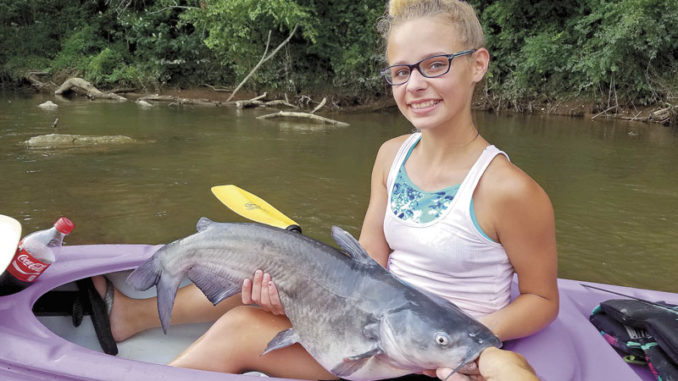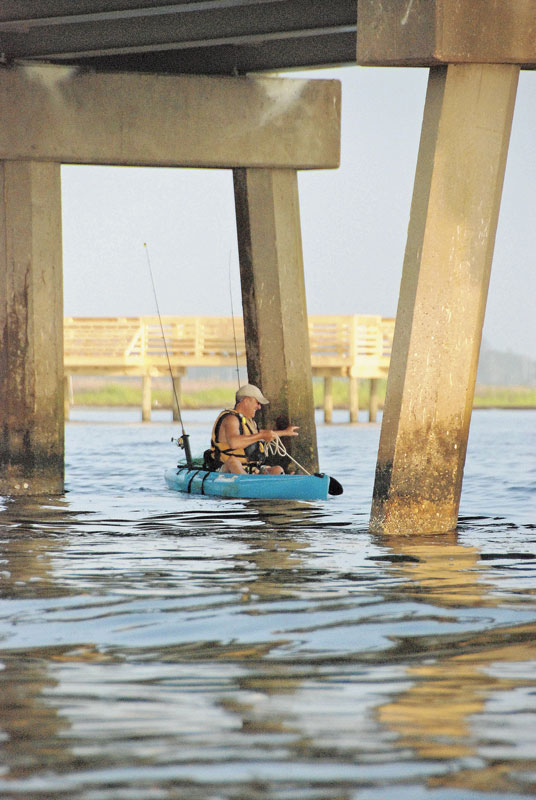

Take a swing at these species, but study up on your August fishing opponents
Sports pundits all say that baseball is a thinking man’s game. It might be boring to watch at times, but so much is going on under the surface that it’s often hard to keep up with the game once you know what you’re looking at.
Were they really referring to baseball, or where they talking about kayak fishing? Either way you look at it, the statement that fishing is mostly a mental game definitely applies. Maybe only the dumb anglers fish in August. But the truly smart anglers, those educated in the ways of whatever quarry they’re after, they catch fish.
Like baseball, even the best batters don’t hit it out of the park every time at bat, but those who are smart enough to look for the right pitch, and anticipate what’s coming next, put the ball in play more often.
Accordingly, here’s some August pitches to watch for.
Batter up!
Best Bets
NORTH CAROLINA SALTWATER
WHAT — Sheepshead
WHERE — Inshore bridge pilings, entire coast
HOW — Sheepshead are not particularly boat shy, especially the ones that live under and around piers and boat docks. However, use the stealth of your kayak to your advantage. Move in, position your boat quickly and quietly and ease baits into the water. The best pilings will have water at least 6 feet deep, even on an outgoing tide and will have plenty of barnacle growth on the vertical posts.
Best and most widely available baits for sheepshead are fiddler crabs. Alternatives are live shrimp or sand fleas (which you’ll probably have to go dig yourself). Use light action spinning rods with 15- to 20-pound braid and a short section of 20-pound fluorocarbon leader. Rig the line with a ¼- to ½-ounce egg weight to make a Carolina rig.
In August, bigger fish are typically found closer to the ocean. Dock or pier pilings close to open water will produce more and bigger fish. In some areas, it may be possible to fish wrecks or pilings off the beaches.
LAUNCH — https://www.ncwildlife.org/boating/where-to-boat/
INSIDER TIP — A reliable trick for hooking sheepshead is to use a No. 2 Aberdeen hook on your Carolina rig. The small gap of the hook often sinks into the lips of the fish as the bait is being chewed. Another benefit is the ability to straighten the hook out if/when the bait hangs up on bottom structure without breaking the line or leader.
NORTH CAROLINA FRESHWATER
WHAT — Catfish and striped bass
WHERE — Tailrace waters below Piedmont reservoirs
HOW — The goal is to fish cut baits on the bottom in moving water. Use cut bait on 20-pound class tackle: a standard, 6-foot-6 medium-heavy Ugly stick, Abu Garcia 6500 reel and 20-pound Big Game mono will work well for both species. Live herring or gizzard shad is the bait of choice. Don’t worry about transporting the bait alive. Net it ahead of time or buy it live by the dozen and seal each dozen in a quart Zip-Lock bag and bury the bags in ice in a bait cooler that will ride in the tank well of your kayak.
Weight each line with an egg or no-roll sinker that will hold in the current you’ll be fishing. Use an 18- to 24-inch leader of 20-pound fluorocarbon. Cut the bait just before placing it on a 1/0 to 3/0 circle or Kahle hook.
You do not want to fish whitewater rapids. Look for areas with appropriate current and current breaks where catfish and stripers will hold in an eddy and watch the flow of water for something to eat. Ideally, position your kayak behind one of these large, surface-breaking current breaks and anchor or stake out the boat.
LAUNCH — Practically every tailrace section below a dam impounding a large reservoir has a public ramp or park just downstream. An alternative is a tributary where moving water enters the reservoir. These areas tend to be smaller and more kayak friendly than the tailrace behind an impoundment dam.
INSIDER TIP —Check the utility that manages a reservoir for a water-release schedule if one is published. Again, the goal is to fish moving water and not rapids, so position yourself accordingly.
SOUTH CAROLINA SALTWATER
WHAT — Sharks, bull redfish, rays and tarpon
WHERE — Inlets along the entire coast
HOW — Anchor on the edge of the channel or a deep hole in the inlet. Fan-cast cut and/or live baits around the boat. Two to three rods is about maximum capacity in a kayak. Weight one line 40 to 50 feet out so the bait is on the bottom. Free-line a second line 80 to 100 feet out to cover the middle of the water column. Add a float or balloon on the third to keep the bait near the surface. Incoming tides are better than outgoing but moving water is better than slack water. Use heavy, 40-pound tackle with 80-pound braid and 8/0 to 12/0 circle hooks.
Bring along a lighter rod and some squid or shrimp to fish for bait. Whatever you catch (where legal) gets cut and put on the hook or fished live and whole.
LAUNCH — Target inlets that don’t get a lot of boating traffic. This often means you have to pull your boat a long way from a public parking area, so get some wheels that roll in sand for your vessel.
INSIDER TIP —Will tarpon and bull redfish eat a bait on wire leader? You have to decide for yourself. The alternative to 100-pound wire leader is 100-pound mono. You’ll lose more sharks and expensive hooks with mono than wire, but you won’t be putting the taste of metal in a fish’s mouth if you believe that makes a difference.
SOUTH CAROLINA FRESHWATER
WHAT — Black bass, white bass, striped bass, white perch
WHERE — Piedmont and Midlands reservoirs
HOW — It’s schooling time. Make your way to the lower main lake on these reservoirs by at least 6 p.m. You can troll deep-running crankbaits between long points and around humps out in the lake to pass the time, but keep your eyes peeled for surface activity.
Have a 7-foot, medium-action spinning rod or two with 12 – 15-pound test rigged with a topwater bait, something that will create a lot of commotion. An alternate bait is a white/black, chrome/black jigging spoon that you can cast a long way.
Make your way to the surface feeding and work the area from the outer edge and determine which way the bait is being herded. Cast in front and work the bait hard, making a lot of commotion.
LAUNCH — Work backwards from the ends of long points or lower-lake humps, all favored schooling spots, and figure out where the closest place to dump a kayak is.
INSIDER TIP — In a kayak, you are limited to how fast and how far you can run and gun. Don’t try to compete with the bass boats, if there are any around. If a school sounds, anticipate the next rise, which will be 100 yards or less, not across the lake. A lot of schooling action takes place just below the surface, so be diligent and keep working the immediate area.




Be the first to comment